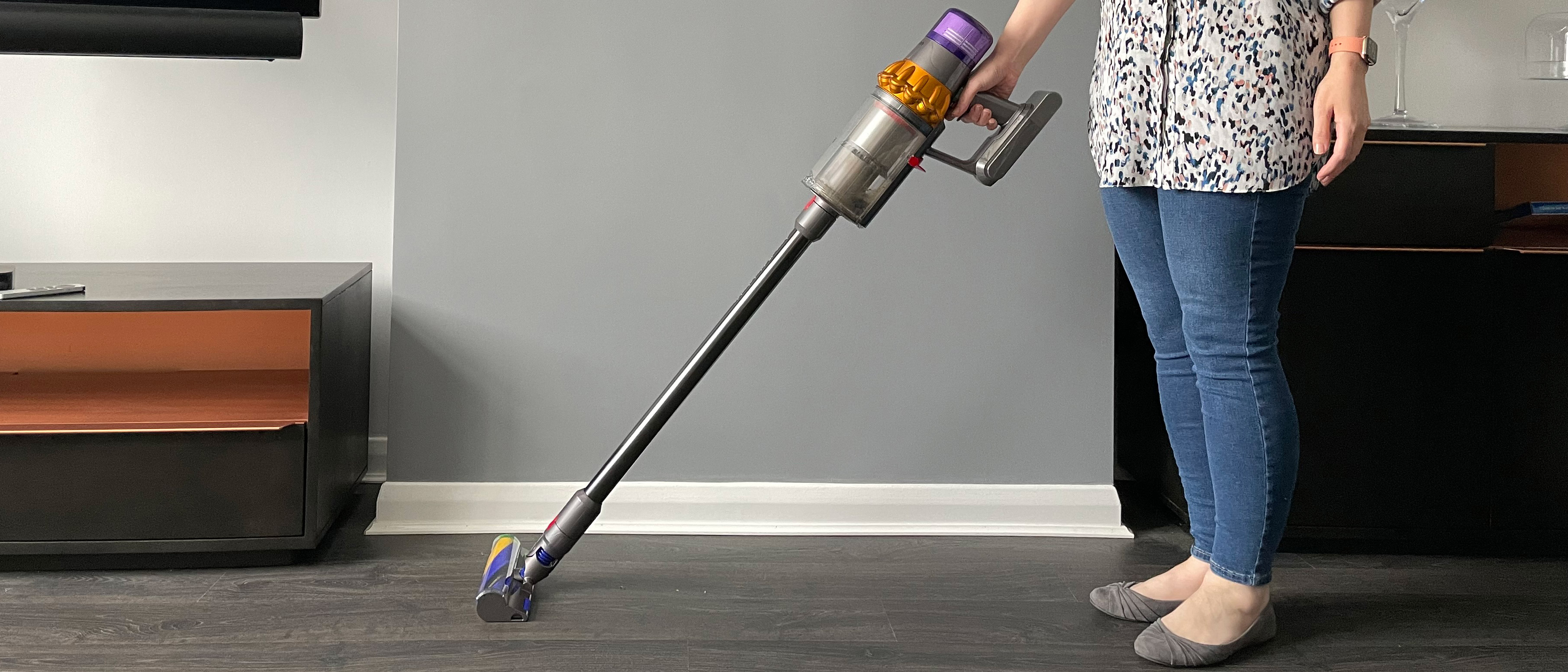TechRadar Verdict
It's no longer the newest model out, but the Dyson V15 Detect is still a superb cordless vacuum with a spree of innovative features. It debuted laser light on the Fluffy Optic tool to illuminate dirt on the floor, showed us an ingenious way to measure how much you’ve cleaned and features automatically adjusting suction for an efficient, low-effort clean. We're not sure all the new features are strictly necessary, and it feels a little heavy (especially in handheld mode) but otherwise it's an outstanding vacuum, and well worth considering.
Pros
- +
Very powerful suction
- +
Auto suction mode is useful
- +
Laser highlights dust on hard floors
- +
Well-designed and high quality
Cons
- -
Premium pricing
- -
Some features perhaps superfluous
- -
Long recharge times
Why you can trust TechRadar
Dyson V15 Detect: two-minute review
For this review, we tested a Dyson V15 Detect, and a Dyson V15 Detect Absolute. They are the same vacuum cleaner in different colorways.
The Dyson V15 Detect is a powerful, tech-packed cordless cleaner from perhaps most innovative vacuum brand in the world. The V15 (and the V15 Detect Absolute, which is the same vacuum in a different color) is able to sense the amount and size of particles it's sucking up, and adjust power in response. It'll even give you a real-time summary of this information, via the LCD screen on the main body of the vacuum. The other headline addition is a green laser on the hard floor floorhead, which illuminates dirt that might otherwise be missed. We're assuming that the new 'Detect' in the name is inspired by one or both of these additions (you can see all the differences in our Dyson V15 Detect vs V11 comparison).
Elsewhere, you'll find impressive suction power, even on the lowest 'Eco' setting. However, our favorite mode was Auto, which adjusts suction based on not only the floor type but also how dirty it is, to ensure a low-effort, efficient clean. In our tests, this vacuum sucked up everything we put in front of it, including handling tangled hair impressively well.
Both the regular V15 Detect and the V15 Detect Absolute (which is the same vacuum in a different colorway) ship with two floorheads: a Digital Motorbar head (for hard floor or carpet) and a Fluffy Optic floorhead (the one with the laser, designed specifically for hard floors). There's also a selection of extra tools for different cleaning tasks. The exact tools included depends where you live and which iteration of the V15 you buy, but if you live with long-haired people or pets, it's worth seeking out the Hair Screw tool, which was new to this model, and great at getting hair out of furniture.
Runtimes are good – up to a full hour on one charge – although recharge is a little slow. If you need longer than that, you'll appreciate that the battery is removable, with additional batteries available to purchase separately.
It's not quite perfect. It's a little heavy, and especially so in handheld mode. It's also frustrating that it switches on via a trigger, which needs to be continually depressed, rather than the one-push button found on other Dyson vacuums. The jury's also out on whether the features like the laser illumination and real-time dust reports are genuinely useful, once the initial novelty factor has worn off.
As you might have guessed, it's also an expensive purchase. While the advanced features and meticulous engineering do help justify the price, there are plenty of cheaper options about with fewer bells and whistles, which will suffice for most people.
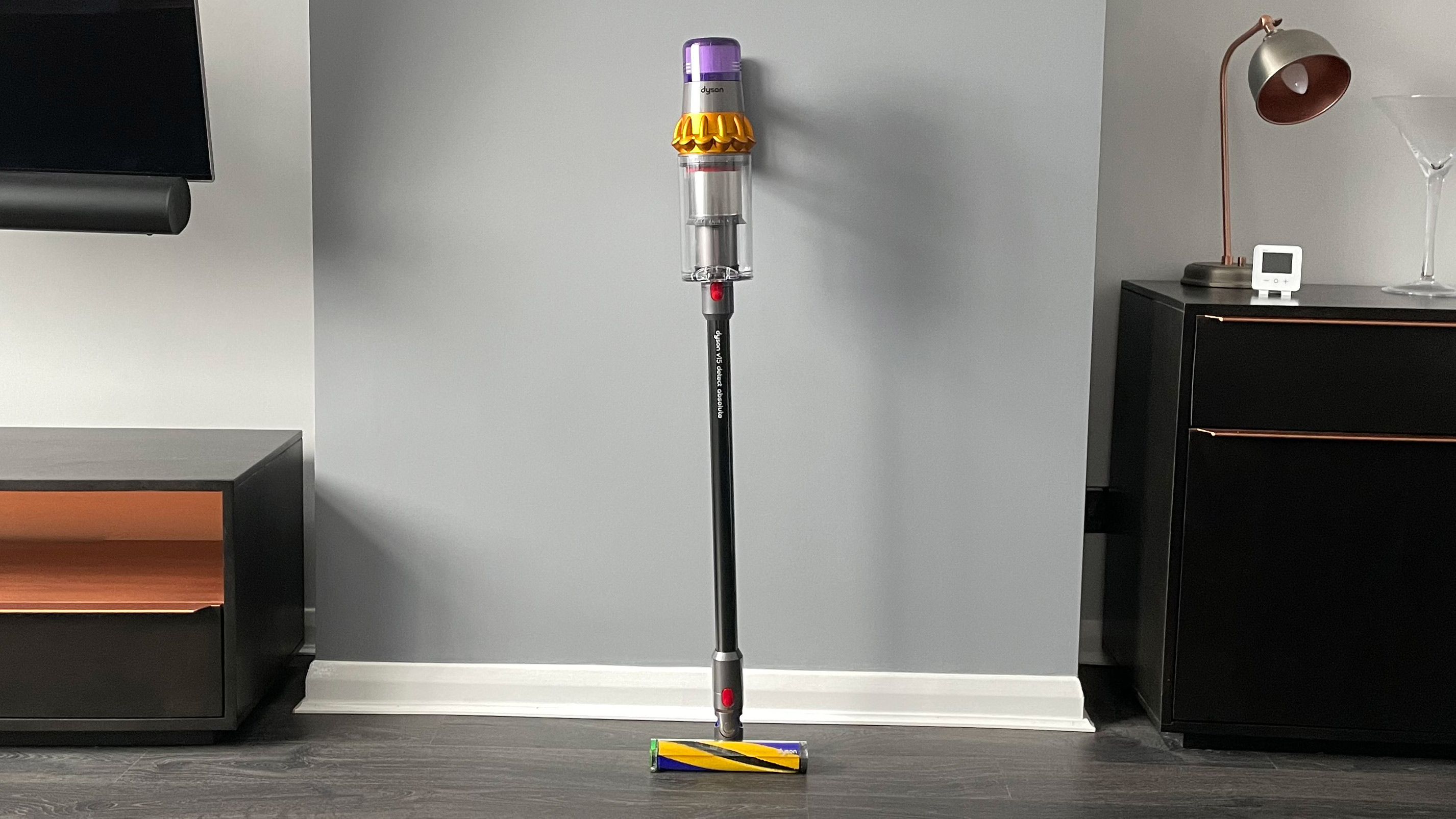
For this review, we tested a couple of V15 vacuums – one in Australia and the other in the UK – to see how they compare to the rest of the best cordless vacuums on the market.
Sign up for breaking news, reviews, opinion, top tech deals, and more.
A bit of context so you know where this model sits in the wider Dyson range. The V15 Detect launched in 2021, at the same time as the (non-flagship) V12 Detect Slim. The previous flagship cordless vacuum was the V11 (read our Dyson V11 review for more on that one). The model to follow was the Gen5detect (get the low-down in our Dyson Gen5detect review. That one features several upgrades to the V15 (see exactly how the two compare in our Dyson Gen5detect vs V15 faceoff), and at time of updating this review is the best Dyson vacuum available, based on specs.
There's also a sister model in the V15 range: the V15s Submarine, launched in 2023. This is similar the regular V15, but has a wet roller head to enable it to wash hard floors as well as just vacuuming. We've tested that separately, in our Dyson V15s Detect Submarine review.
That's the short version. Read on for our full Dyson V15 Detect / Dyson V15 Detect Absolute review, and to learn if it's the best vacuum cleaner for your needs.
Dyson V15 Detect review: price & versions
- List price: $749.99 / £649.99 / AU$1,449
- Launched: 2021
As with most Dyson cordless vacuums, there are a few different versions of the V15 Detect, with an extra word added onto the end of the name. Generally, it's the same base model, but sometimes there are differences in the range of tools included. That can make examining the pricing a little difficult, but to give us an idea, we'll be looking at what's available to buy direct from Dyson at time of updating this review. There may be other versions and different pricing available at other retailers.
In the US there's the Dyson V15 Detect, with a list price of $749.99. There's also the Detect V15 Detect Absolute for the same price (reduced to $599.99 at time of update). They're the same vacuum in two different colorways, and in this case even the tools included are the same.
The UK just has the Dyson V15 Detect Absolute, at a list price of £649.99, reduced to £549.99 at time of update. It's the same in Australia – just the V15 Detect Absolute, this time with a list price of AU$1,449.
Regardless of which iteration you go for, it's going to fall into the premium price category. It's generally a bit cheaper than its successor, the Gen5Detect (from $949.99 / £769.99 / AU$1,549 at list price). If you're hoping to score a discount, Dyson promo codes are rare, but we do sometimes see Dyson deals, especially around events like the Black Friday sales.
- Value for money score: 4 out of 5
Dyson V15 Detect review: design
- Upgraded motor compared to previous flagship model
- LCD display shows info about dust collected and remaining run time
- Wand can be removed to turn into a handheld
True to Dyson aesthetics, the V15 Detect is a beautiful machine to look at. Under the hood, the motor has been upgraded from its predecessor's (and was improved again for its successor), and generates 230 air watts of suction power. Other than that, it looks similar to the other modern V-range vacuums, comprising the motor, cyclone array and dust canister, in an in-line arrangement. We might have preferred a bigger dustbin on this model, but it's just the standard 0.2-gallon / 0.75L canister that's used in the Cyclone V10.
Inherited from the V11 is the swappable battery pack. This can come in handy if you've got a large home and would prefer to get the vacuuming done in one go instead of recharging at the mains – that can take a few hours (more on that later).
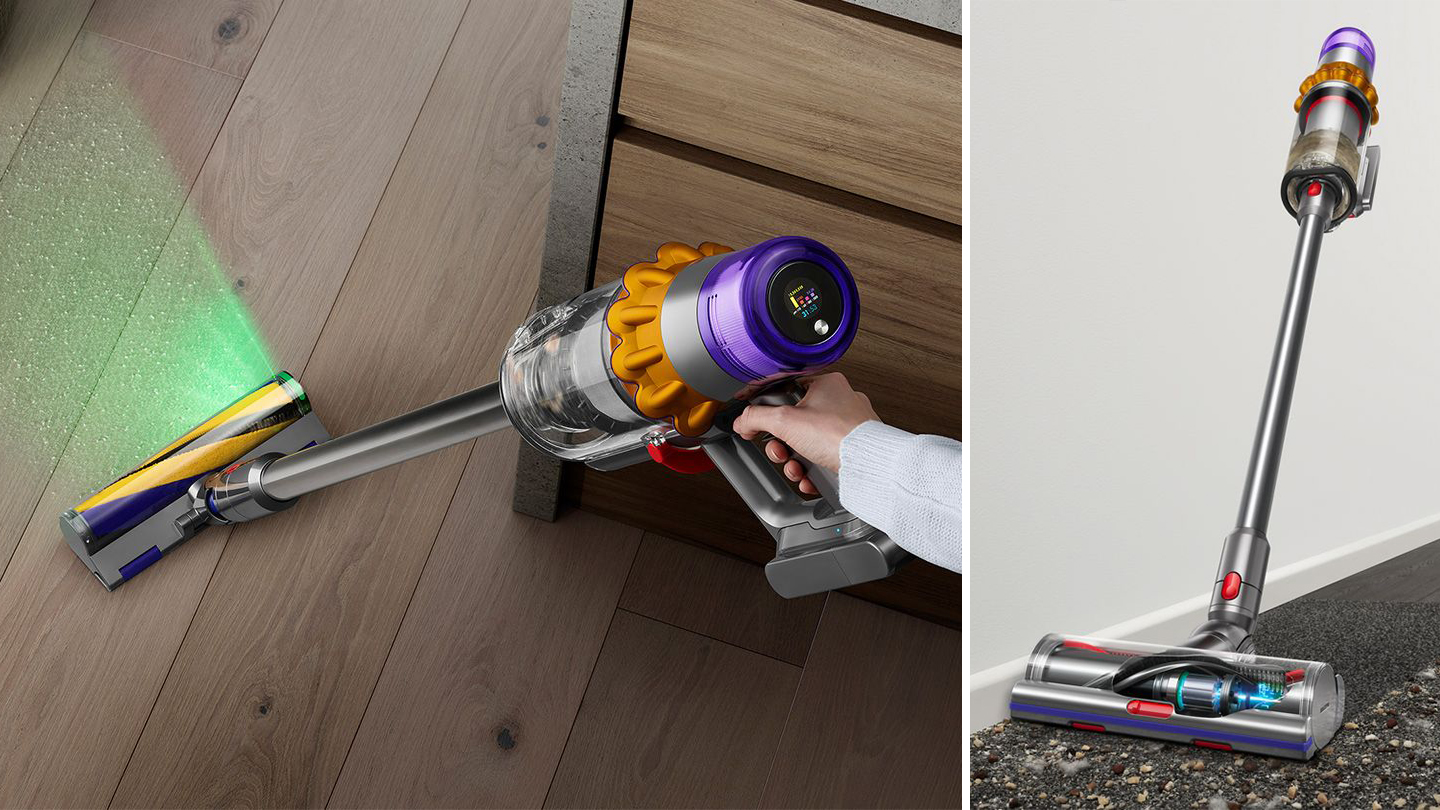
That battery, though, makes the weight distribution of the V15 Detect quite uneven. It weighs in at 3kg, but feels top-heavy, and it's tiring to use for longer cleaning stints. Our testers found their arms getting tired after using it for about 30 minutes, and they needed to keep switching hands regularly if they wanted to clean for any longer than that.
While later models (and, actually, the V12 Detect Slim that launched alongside the V15) switch on and off via a single-press button, but the V15 still uses a trigger that you need to keep continuously depressed. That, combined with the uneven weight distribution, makes the V15 even more of a workout for your arms. We found it less of an issue with the smaller and lighter V7 and V8.
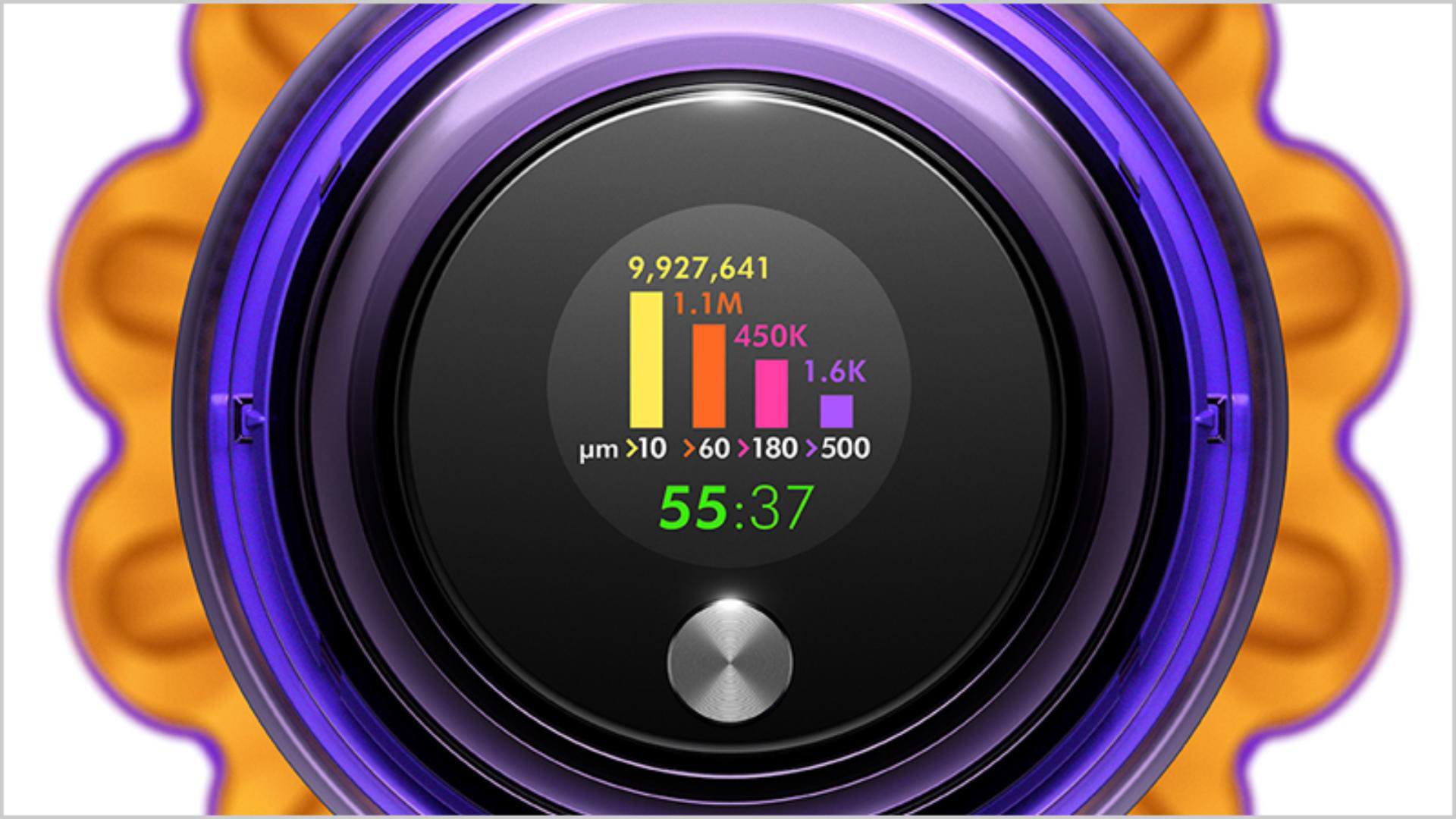
One headline upgrade on the V15 Detect and Detect Absolute is the addition of a tiny piezo sensor, housed within the vacuum's handheld unit, which can measure acoustic vibrations from microscopic particles as small as 10 microns. As dust and debris get sucked in, they reverberate off the sides of the vacuum, and the piezo sensor uses those changes in vibrations to measure not just the size of the particles, but also the number.
These are then graphically displayed on a one-inch circular digital screen. As you clean, you'll see the representation change in real time and, when it finally becomes static, you'll know there's nothing more for the vacuum to suck up. This is a great feature for effective cleaning, but if the V15 Detect is out of your price range the cheaper Shark PowerDetect Cordless Stick Vacuum has a similar feature that's not as advanced but still pretty impressive.

Displayed below the graph is a countdown clock representing the remaining runtime, and it also displays the power mode you've chosen. There are three power levels, which can be selected using a silver button on the circular panel. Eco is a lower-suction mode, Boost is a more powerful mode for ingrained dirt, and Auto mode will intelligently adjust suction based on the floor type and how dirty it is.
All versions ship with two floorheads: a Digital Motorbar head (previously called the High Torque head) and a Fluffy Optic head (previously called the Laser Slim Fluffy head, and currently referred to as the Illuminated Cleaner Head in the UK... possibly because they couldn't trademark the 'Fluffy' name there).
The Digital Motorbar is a motorized head that features a couple of rows of 'teeth' that cut hair and fur into smaller pieces that get sucked up easily and thus prevent tangling around the bristles of the brush. Perhaps most exciting is the fact that this floorhead can monitor brush bar resistance to enable the vacuum to increase or decrease suction based on floor type.
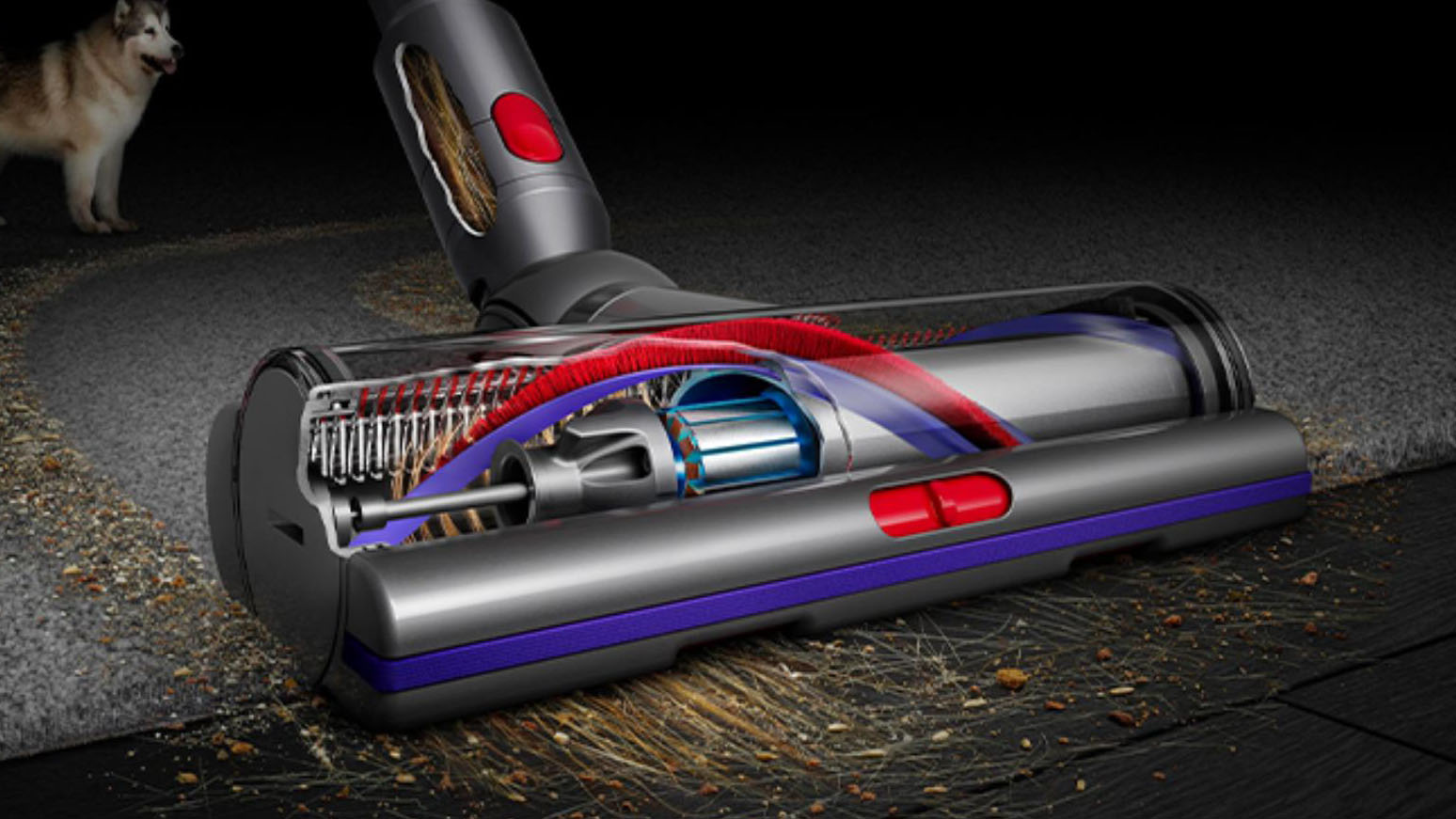
The Fluffy Optic head is designed specifically for hard floors, and it has had a redesign from the one shipped with previous V-series models. The whole head has been slimmed down (although the footprint remains the same), but the major difference is that there's now an in-built laser diode (class 1, so it's safe for humans and pets).
Thanks to a custom-designed lens (which is only marginally bigger than a grain of sugar), the laser emits light at an angle that reflects off solid particles to highlight them green. The light is activated via a small switch on the top of the floorhead, and the fluffy part is also washable, so you can keep it at peak performance. This specialized floorhead helped the V15 score a spot in our ranking of the best vacuums for hardwood floors.
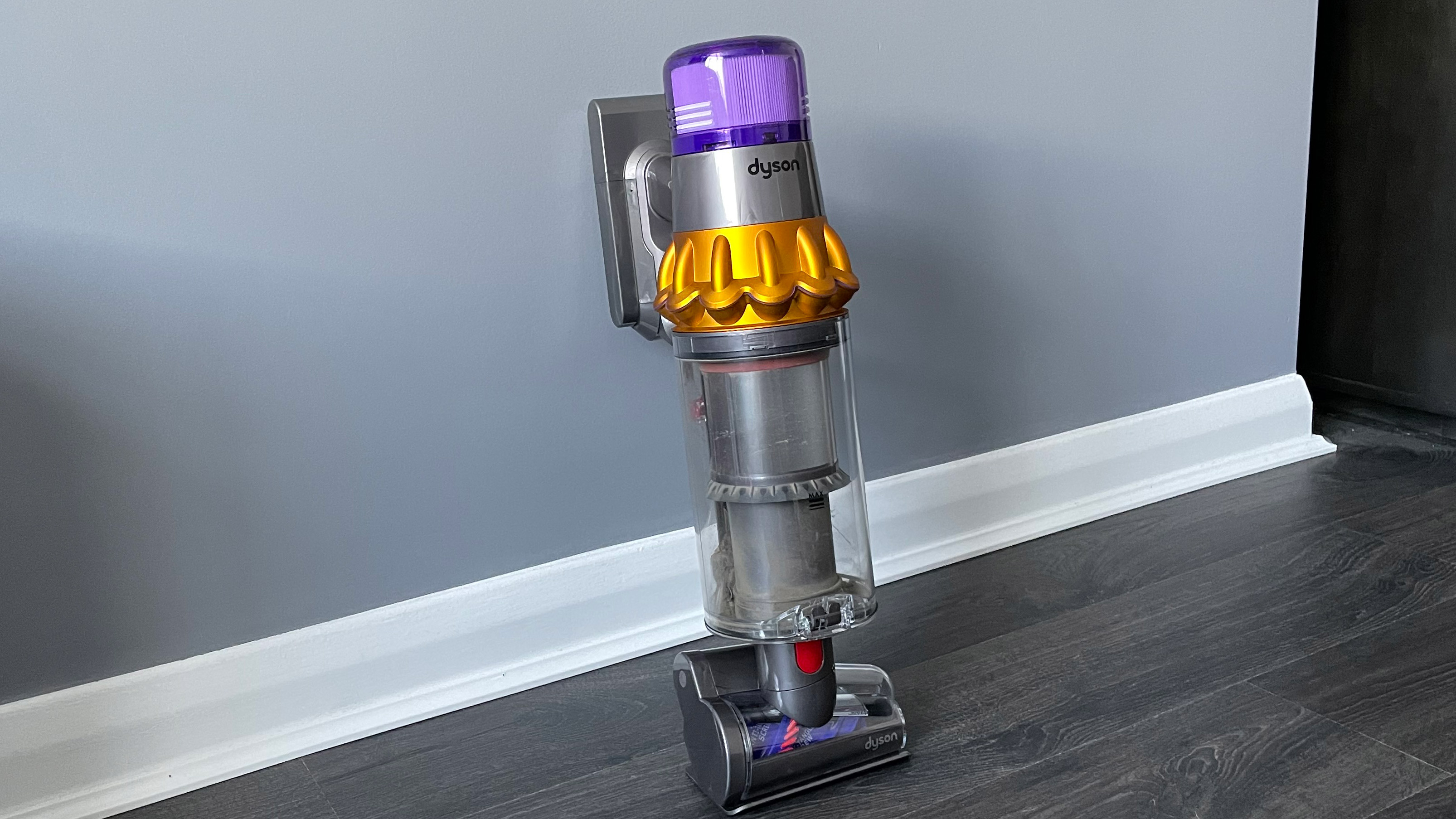
Like other Dyson cordless vacuums, you can convert the V15 Detect Absolute into a handheld cleaner by removing the main wand and attaching any of the other tools. Exactly which tools are included will vary depending on where you live and which iteration of the V15 you buy, but all are well-designed and useful.
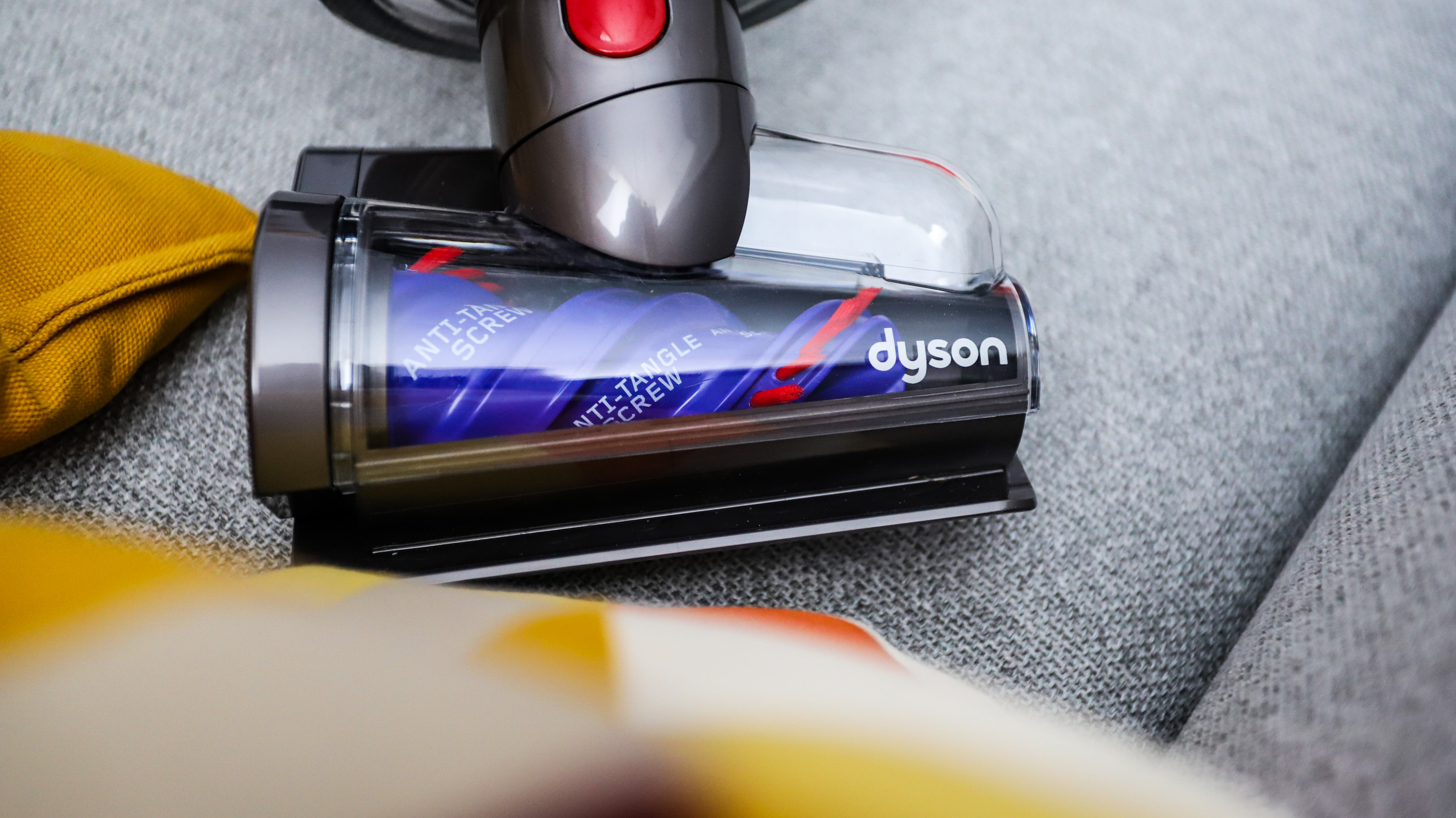
If you want to be able to deal with hair (human or pet) in upholstery or furniture, look out for the Hair Screw Tool. This uses the principle of an Archimedes screw, with a tapered design that directs strands of hair or fur (no matter how short or long) towards the narrow end. This is where the suction hole is, allowing whole locks to get sucked up into the bin. Even the bristles have been placed at an angle, to ensure there's no tangling at all. This tool was new with the V15, but is compatible with older models and available to purchase separately.
- Design score: 4 out of 5
Dyson V15 Detect specs
Weight: | 6.83lbs / 2.96kg |
Dimensions (H x L x W): | 49.6 x 10.5 x 9.8in / 126 x 26.6 x 25cm |
Filter: | Whole-machine filtration |
Bin capacity: | 0.2 gallon / 0.77L |
Max suction: | 240AW |
Cyclones: | 14 |
Max runtime (Eco mode): | 1hr |
Runtime in Boost mode: | 18 mins |
Charge time: | 4hrs 30 |
Dyson V15 Detect review: performance
- Powerful suction; great on carpet and hard floors
- Laser highlights dust that's invisible to the eye
- Auto mode is an excellent, low-effort feature
Even though there are three power modes, the V15 Detect is just fine at its lowest setting. To see how it coped with different types of debris, our testers sprinkled fine dust, biscuit crumbs and cereal (separately) on both carpet and hard floor. We found that even in Eco mode, it sucked everything up with just one slow pass. It also did a pretty good job on a hair-entwined carpet in Eco mode.
During our testing, though, we found the Auto mode the best – it was like a set-and-forget option that handled hard floors and carpets alike. Additionally, when using the Digital Motorbar head, the suction changes reactively when surfaces change, increasing automatically when it senses a rug or carpet.
This graphical representation of what you're cleaning also works really well. All particles are divided into four categories, depending on their size, and as you clean a specific surface, you’ll find the bars rising. When they become static, you know that the area has been cleaned to the best of the V15 Detect’s ability. We're not sure this feature is strictly essential, especially after the initial novelty had worn off, although we did find it a good way to see when a floor had been cleaned properly.
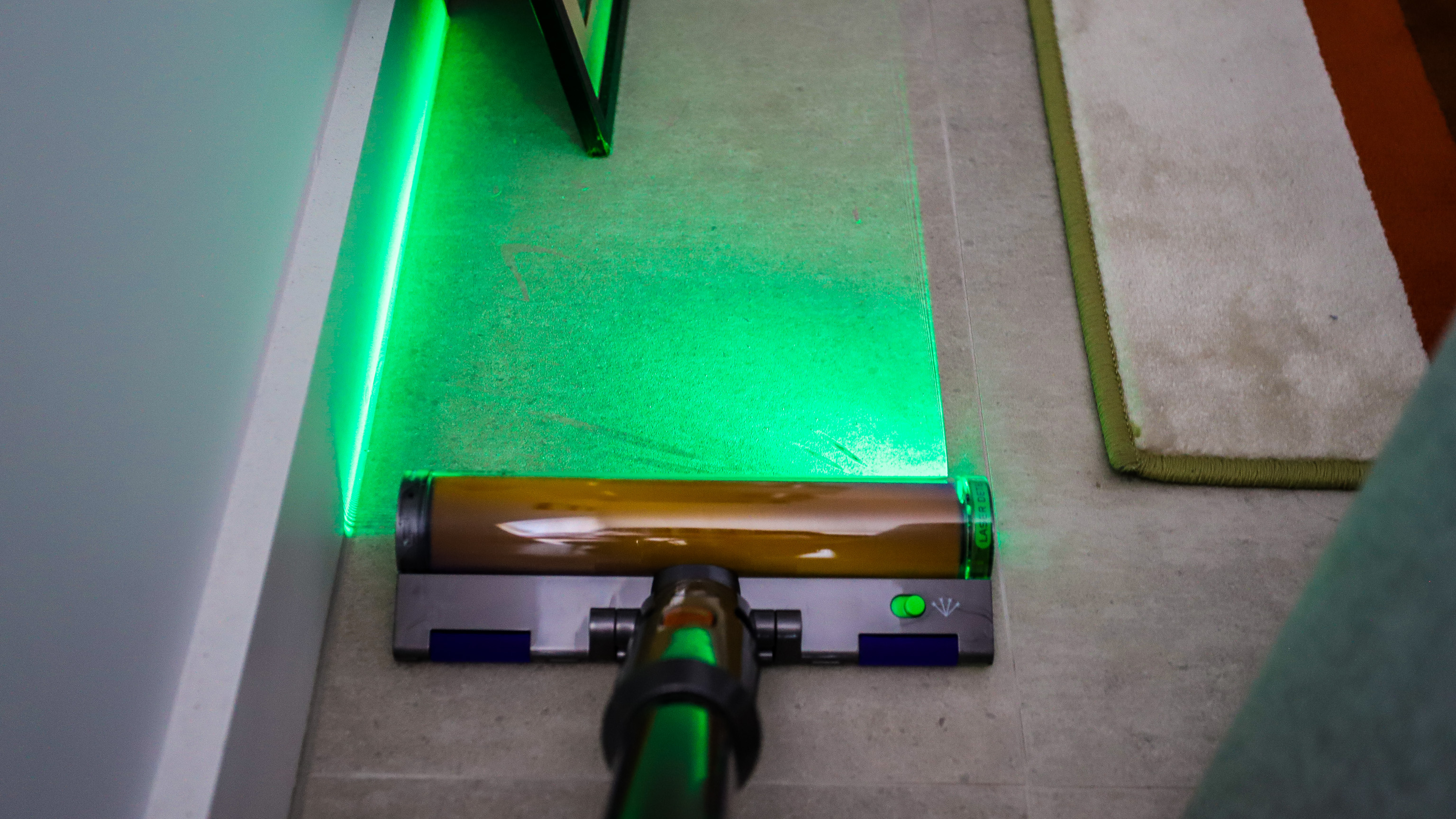
The laser on the Slim Fluffy tool does exactly what it says on the tin, highlighting particles you normally wouldn’t see with your naked eye, either illuminating a bright green or creating visible shadows. One of our testers deliberately missed the edges of a room with hard floors, and then pushed the head towards these edges – with the green laser illuminated, they were shocked by just how much dust, which wasn’t previously visible, was on the floor.
Our other reviewer wasn't quite as sold on this feature, ultimately deciding it was a little superfluous. They found that dust tended to settle on the inside plastic of the tool, diminishing its ability to, well, shine a light. They had to repeatedly wipe down the inside of the Laser Slim Fluffy to get the best results, and after a while found themselves leaving it switched off, and relying on the display as an indicator of when there was nothing more for the V15 to suck up.
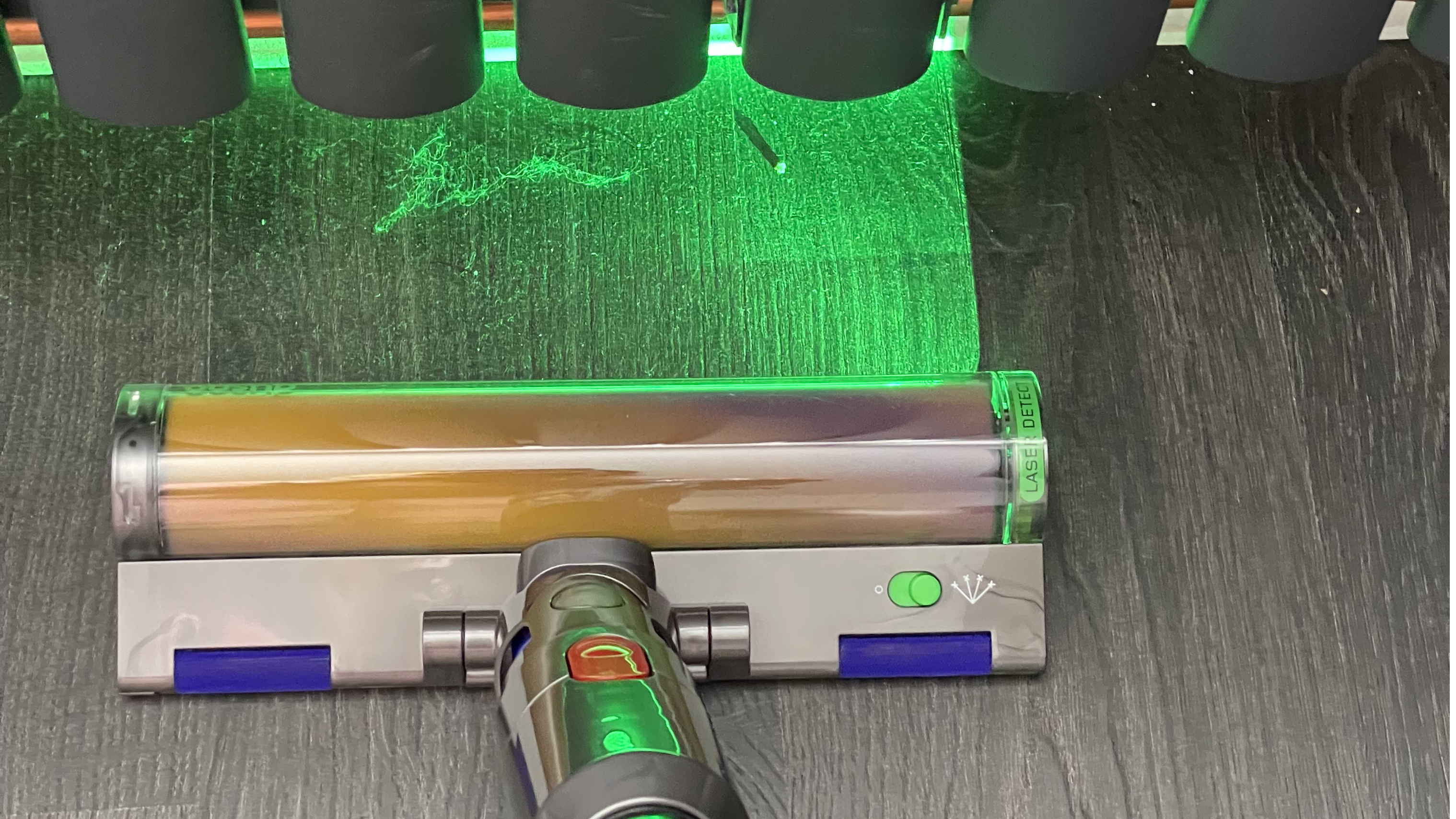
Our second tester also found the floorhead a little tricky to swivel around. Because the Digital Motorhead can swivel a lot more, they found themselves using that one on hard floors as well.
(It's worth noting that the newer Gen5detect has a brighter laser, which is more visible in well-lit rooms, and the same tester was far more impressed with the upgraded version.)
Converting the vacuum to handheld mode and back again is simple – just remove the telescopic tube, clip on your desired attachment and you’re ready to go. However, the click-in battery pack does make the barrel feel heavier than older models like the V7, V8 and V10. Both of our testers found that holding aloft the V15 for more than a minute or two was quite difficult. The Gen5detect simplifies the process further by hiding a tool inside the wand, but that model is even heavier.
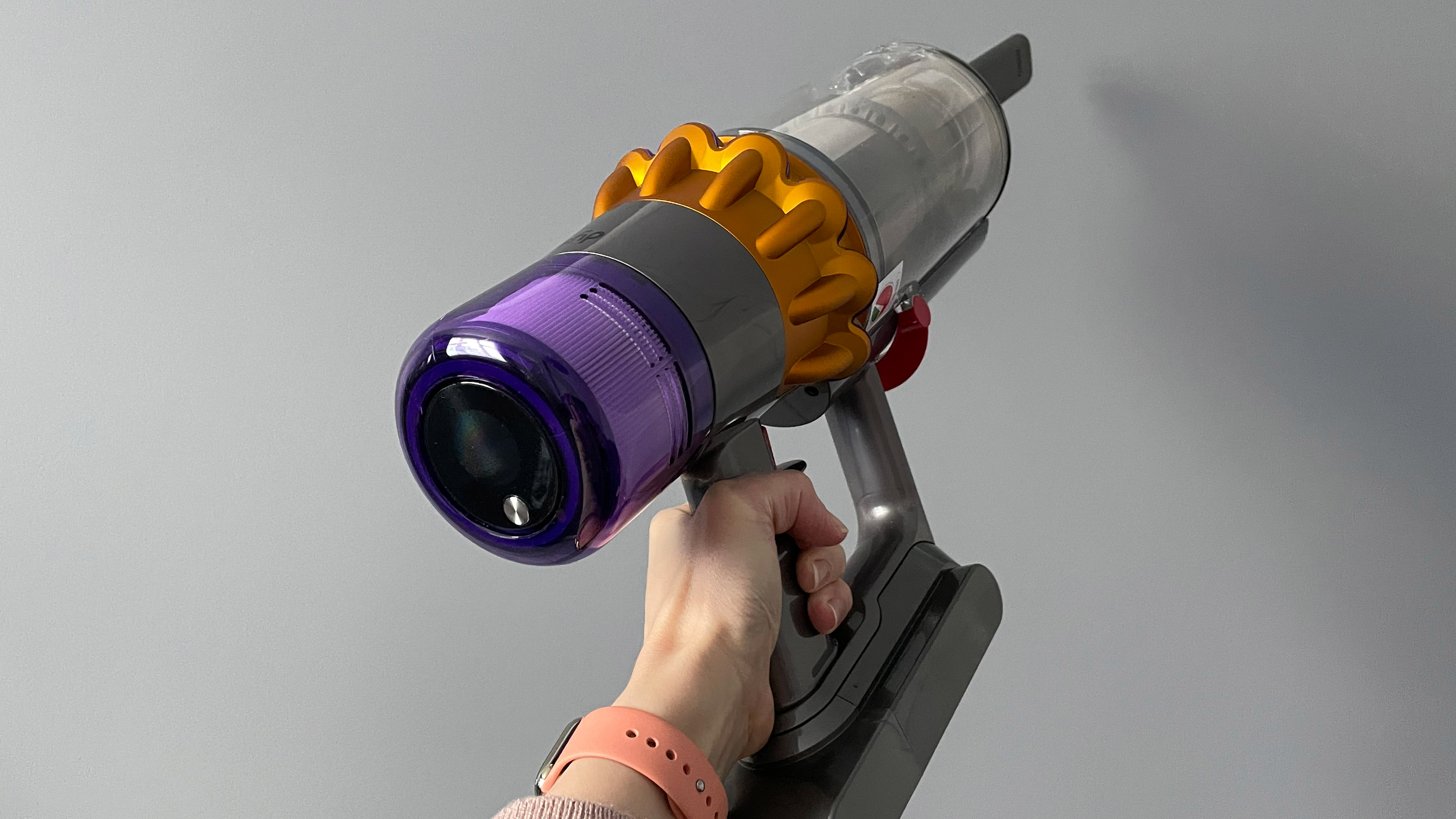
We can't fault the V15 Detect's cleaning power in handheld mode, though. One tester used it to clean their car, and it sucked up all of the dirt and debris such as small stones and even a few leaves, along with human hair that had collected on the driver’s seat, with ease.
Unlike today's best car vacuums, which are designed specifically for this task, converted floor vacs like this one are typically quite bulky when used in handheld mode. Our reviewer struggled to fully clean under the driver and passenger front seats, as well in the storage areas on the center console, which frequently attract dust and debris.
The exact tools that are included with the V15 Detect and Detect Absolute varies by country and version, but you'll typically get a Crevice tool and a Combination tool, which we found were good for edges and narrow spaces.
Both of our review models came with a new-to-this-model Hair Screw tool. This works best as part of the handheld unit to remove pet and human hair off smaller surfaces like sofas, car seats or pet beds. It is possible to also use it on carpeted floors, but given it's small footprint, it's far more efficient to use the much larger Digtial Motorbar head for this task.

Either way, the Hair Screw Tool is a marvelous piece of engineering. When testing it, we removed a clump of hair from a brush and placed it on a sofa – the anti-tangle tool sucked it all up without a single strand getting caught anywhere. It all curled up and got sucked right into the canister. However, we did find this tool could be a little less effective at collecting dust and dander from upholstery, when compared to the Mini Motorized head included with previous models.
Emptying the V15 Detect’s bin is easy. Once the wand and any cleaning attachments are removed, the red lever on the canister pushes open the lid and all that dirt comes right out in a single move.
One final performance element to discuss is noisiness. We were impressed with how much quieter the V15 Detect is in low-power settings as compared to some of the older V-series models. However, bump the suction mode to Boost and it hits 81 decibels – as loud as a truck trundling down a highway at 65kph.
- Performance score: 4.5 out of 5
Dyson V15 Detect review: battery
- Up to a full hour's cleaning on Eco mode; 18 minutes in Boost
- Battery takes up to 5 hours to fully recharge
- Swappable battery reduces interruptions to cleaning
On the lowest-powered, Eco setting Dyson claims the battery will last up to 60 minutes. That's the same as the V11, although because the suction power has been improved over that model, you should be able to clean more efficiently with the newer V15. On test, the claims were accurate – one of our review models managed a respectable 59 minutes, and the other clocked up nearly 61 minutes.
If you prefer the Auto mode, you'll get about 40 minutes of runtime per charge, which is enough for the general upkeep of a small two-bedroom house. However, because of the intelligent nature of this mode, runtimes will vary depending on the types of floors you have, and how dirty they are. Bump up to Boost and you'll only get about 18 minutes of power.
The Auto mode suited our testers best, but even the Eco setting has plenty of suction power to clean up a small mess. So the latter is your best bet to maximize on battery life. A countdown of how long you have left is handily available on the digital display.
If you want to be able to clean for longer than 60 minutes, then you’re going to need an additional battery pack. This would be handy in large family homes, because recharge times are long – our testers found a full recharge took between four and five hours.
- Battery score: 4 out of 5
Should I buy the Dyson V15 Detect?
Section | Notes | Score |
|---|---|---|
Value | The great quality and impressive engineering / features go some way to justifying the premium price, but there are cheaper (still capable) options that cost much less. | 4/5 |
Design | Sleek and easy to use, with well-designed attachments. However, a little heavy and unwieldy, and we'd prefer a one-press switch to a trigger. | 4/5 |
Performance | Excellent suction, even in the lowest power mode. Auto mode works effectively and makes cleaning fuss-free. | 4.5/5 |
Battery | 60 minute maximum runtime is great, but recharge times a little slow. | 4/5 |
Buy it if...
You want a low-effort, but efficient clean
The Auto mode means you don't have to mess around adjusting power levels, so you can just focus on whizzing round the house. You're paying a premium for features like this, but if it's in your budget, it sure is nice to have.
You want 'proof' that your home is clean
Between the piezo sensor and laser beam, there's no doubt that the Dyson has pulled off another engineering masterpiece. You can now see what you need to clean up (even if it’s invisible to the naked eye) and see how much of it you’ve captured.
You want powerful suction
The Dyson V15 Detect is a powerful vacuum that can suck up everything in its path in a single sweep. It's not as sucky as later models, but it's still an excellent performer.
Don't buy it if...
You're on a budget
How much you're willing to spend on something is always an important consideration, and the V15 Detect is definitely an investment. If you're happy to sacrifice some of the fancier features, there are plenty of capable vacuums that cost much less.
You live in a large home
The 0.76L bin, while fine for the average two- or three-bedroom home, might be too small for a larger family home. If you live in a large space, you’ll find your cleaning run being interrupted by trips to the dustbin to empty the canister. Many of the Dyson stick vacuums have an Outsize version, but not the V15.
You want something easily maneuverable
Due to the weight distribution (and weight, period), the V15 Detect can be uncomfortable to use for long periods, and especially in handheld mode.
First reviewed: May 2021

While she's happiest with a camera in her hand, Sharmishta's main priority is being TechRadar's APAC Managing Editor, looking after the day-to-day functioning of the Australian, New Zealand and Singapore editions of the site, steering everything from news and reviews to ecommerce content like deals and coupon codes. While she loves reviewing cameras and lenses when she can, she's also an avid reader and has become quite the expert on ereaders and E Ink writing tablets, having appeared on Singaporean radio to talk about these underrated devices. Other than her duties at TechRadar, she's also the Managing Editor of the Australian edition of Digital Camera World, and writes for Tom's Guide and T3.
- Carrie-Ann Skinner
- Ruth HamiltonHomes Editor
